Briefly, I am interested in the structure and function of organisms as these topics relate to ecology, evolution, and behavior. I am especially interested in reptiles and amphibians, with much emphasis on the biology of snakes. My approaches combine field research with experimental laboratory investigation, with the aim of achieving an integrated understanding of adaptation and ecology. With respect to scientific organizations, meetings, and journals, I am most closely associated with the disciplines of comparative physiology, physiological ecology, experimental biology, and herpetology.
Current research projects in my laboratory include the following:
1) Water balance and its influence on the ecology of marine snakes. Early projects have demonstrated the reliance of file snakes (Acrochordus granulatus) and sea kraits (Laticauda spp.) on fresh drinking water, which is obtained from springs, estuaries, or freshwater lenses that form on the sea from rainfall. Presently I have active collaborations with Dr. Ming-Chung Tu in Taiwan where we first discovered freshwater dependence of sea kraits at Orchid Island, with funding from the National Geographic Society (Lillywhite et al. 2008). Ongoing investigations are documenting the abundance and distribution of sea kraits in relation to the distribution and timing of precipitation.
Current funding from the National Science Foundation is supporting efforts to document freshwater drinking behaviors and physiological dependence in a variety of sea snake species, with emphasis on the pelagic and most highly adapted marine snake Pelamis platurus. Our present investigations are focused primarily in Costa Rica where we are documenting drinking behaviors, dehydration and distributional responses to drought. I am also investigating the genetic structure of Pelamis popoulations in collaboration with Coleman Sheehy III of the University of Texas at Arlington.
Other investigations of sea snakes include (i) ecological modeling to understand the evolutionary origins, present distribution, and putative changes of distribution related to climate change; (ii) laboratory investigation of skin structure and function related to water permeability; (iii) factors responsible for present changes in population abundance and local extinctions.
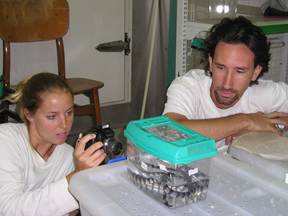 Leslie Babonis (left) and Coleman Sheehy III (graduate students) photograph Laticauda spp. sea snakes drinking fresh water.
Leslie Babonis (left) and Coleman Sheehy III (graduate students) photograph Laticauda spp. sea snakes drinking fresh water.
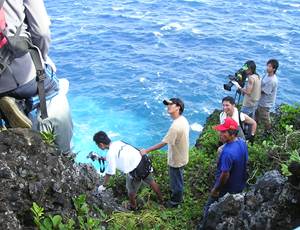
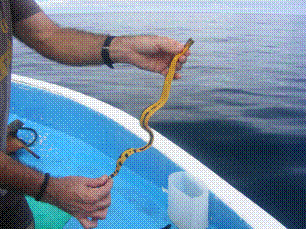
Alejandro Solórzano holds an unusual color morph of Yellow-bellied sea snake, Pelamis platurus. Costa Rica, February 2009.
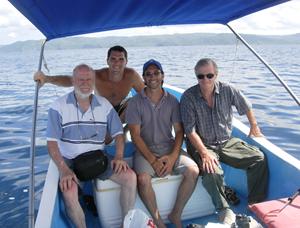
Research team in Costa Rica, June 2010.
Left to right: Harold Heatwole, Joe Pfaller, Coleman Sheehy III, Harvey Lillywhite.
2) Ecology and physiology of insular cottonmouth snakes (Agkistrodon piscivorus conanti) living in mutualism with colonial nesting birds at Seahorse Key. These are multifaceted, long-term investigations related to diet (Lillywhite & McCleary 2008), energetics (McCue & Lillywhite 2004), social behaviors, water balance, genetic structure (recent doctoral dissertation by Ryan McCleary), and relationships with colonial nesting birds. Seahorse Key is a small island near the Gulf coast of Florida and is part of the Cedar Keys National Wildlife Refuge. The University of Florida operates a small field station (UF Marine Laboratory at Seahorse Key) at the island in cooperation with the USFWS. The island is a sanctuary for colonial nesting water birds, which live in close association with a dense and unique population of cottonmouths that we study. Website: http://www.biology.ufl.edu/CENTERS/shkml/index.htm
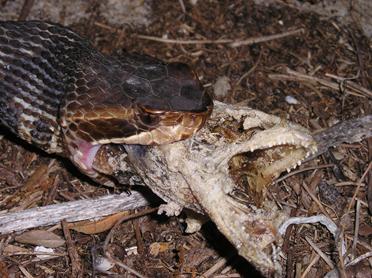
A Florida cottonmouth (Agkistrodon piscivorus conanti) feeding on carrion in the form of a long-dead and dried toadfish at Seahorse Key.
3) Cardiovascular structure and function in snakes with emphasis on adaptations to gravitational stress. I am interested in how snakes maintain blood flow to the head while preventing edema in the lung or lower body during climbing when the animal is upright (Lillywhite 2005). In this context, arboreal snakes and aquatic snakes such as sea snakes are at the opposite ends of an “adaptive spectrum.” Spin-off from these studies includes behavioral ecology of arboreal species of snakes (Lillywhite & Henderson 1992) and respiratory or diving physiology of aquatic snakes (Lillywhite & Donald 1994).